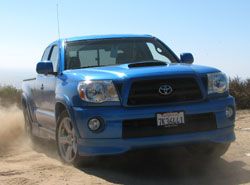KELSEY MAYS
Living Editor
 Toyota Tacoma (Photo courtesy Chris Segal/Perspectives Editor)
Toyota Tacoma (Photo courtesy Chris Segal/Perspectives Editor)
The pickup truck is a king-size affair. Its history portrays a machine with which folks hauled plots of uprooted earth, building materials and other debris from farm house to shipping yard. Though today’s owners see more Home Depots than freight depots, the pickup remains a cornerstone icon: Whether it’s a new refrigerator or the soon-to-be flower garden, the truck will cart it to places no matter the distance, road conditions or outside temperature.
But somewhere along the way, a few people decided to bolt on strips of chrome and a bumper guard or two, and give these rigs a whole new name: sport trucks. Often powerful but seldom beautiful, these dirt haulers now haul tail down the interstate. Mark this as another sign the world will soon end — although we’ve seen a Porsche SUV and too many Pontiac Azteks, and the sun still rises each morning.
This brings me to the 2005 Toyota Tacoma X-Runner, the latest of these experiments. Affixed with giant wheels and a bevy of front, side and rear ground effects, this truck sports more cladding than the Bismarck. Gone are the grays and browns of previous workhorse brethren — the X-Runner dons Speedway Blue paint and a prominent hood scoop.
The look grows on me, but even after a week’s tenure I can’t call it attractive.
A lengthy heritage means there ought to be some bite behind this new bark. The Tacoma has been around officially since 1995, but traces its DNA well back into the 1980s as Toyota’s unnamed pickup truck. It’s now the smaller of two pickups in the company’s lineup, the other being the full-size Tundra. Redone this year, the new Tacoma follows truck designs these days with larger headlights and a gaping center grille. Requisite increases in power, capability and general curb appeal also join the menu.
The X-Runner is not the only Tacoma available — to be fair, Tacoma’s lineup offers plenty of choices that will make Home Depot runs with nary a grunt of resistance. There are 18 models between single, access and double cabs with a range of drivetrain and engine options running from a tick under $14,000 up to near $26,000, including destination.The X-Runner is an enigma in the bunch, though. Available only with rear-wheel drive and access cab layout, Toyota bills it as a “high-performance sport truck.” Besides the exterior duds, it features a torquey V-6, six-speed manual transmission and stiffer shocks with a rear anti-roll bar, an equipment combination no other Tacoma receives.
Turn the key, and there’s a guttural roar from the 4.0-liter V-6. It’s a healthy beast, with 245 horsepower and — more impressively — 282 pounds-feet of torque. First introduced in the 2003 4Runner SUV, the engine features cam-phased variable-valve timing and plenty of displacement for towing, hauling and other truck-ish duties. In the Tacoma, it’s the uplevel engine. The base powertrain is a 2.7-liter 4-cylinder with 162 horsepower and 183 pounds-feet of torque.
Though more gradual than immediate, the V-6 pushes ahead with stubborn thrust. Combined with the manual transmission, it musters up a decent impression of sporty driving. But this engine is more suited toward workhorse activities, so wringing out the tach to its 5,500-rpm redline isn’t that inviting of a task. It certainly hustles — Toyota claims a 0 to 60 mph time of fewer than seven seconds — but shows its metal grunting over uphill speed-bumps in second gear, rather than tearing away from stoplights in first.
So I put that grunt to the test, taking the Tacoma down to Orange County to pick up a couch for the Graphic. Laden with two bodies and the sofa, the X-Runner loses its more exuberant character but still manages freeway speeds with relative ease — in fifth gear instead of sixth, a tangible reminder of its decreased gusto.
Free from cargo, the X-Runner argues its case as a “sport truck” best in the handling arena. Its layout — a body-on-frame vehicle with a live rear axle, as almost all pickups are — corks the fun well short from the visceral joy of a tightly sprung sports car with liberated rear wheels. But given those constraints, it’s only a near miss. Round winding corners up the canyons beyond Malibu, and the rear anti-roll bar goes to work minimizing body roll. Steering tracks reasonably well, though feedback lacks some tactility. Nailing the throttle around corners produces a whiff of oversteer as the rear tires catch half a breath later.
Give credit to the X-Runner’s 18-inch wheels and sticky 255/45 rubber. Those tires simply don’t like to slip, swing or slide — for better or for worse, if you’re into that sort of thing.
Descending through downhill corners, the brakes cut speed as ordered. On paper it’s inexcusable for Toyota to put rear drum brakes on anything they call “sport” (note the ill-fated Celica sports coupe with drums on its base model). Yet the X-Runner’s rear drums and front discs perform a step above most trucks: The pedal feels linear, and though deceleration isn’t noteworthy, it’s quick enough to send front-seat detritus into the dash.
Weekend shenanigans aside, the Tacoma settles into a daily routine that’s mostly welcome. The stick shift swims from one gate to the next with inexact operation, but it’s a child’s toy to use – and no truck ever won an award for manual-shift precision. Cabin noise is fairly low at high speeds, though the engine drowns out CDs and conversation between 2,000 and 3,000 rpm. Fortunately, there are plenty of gears to keep the tach either above or below this zone, and ample torque for either task.
In standard Toyota fashion, the Tacoma sweats the details with interior fit and finish. From the precise click of each knob on the air conditioning controls to the flush panels adorning doors and dash alike, there’s a palpable sense this is a step beyond most truck cabins. If anything, it loses some of the sport-truck aura. There are no white-faced instrument gauges or highly bolstered racing seats, and the four-spoke steering wheel came straight out of a Camry. In light of the hysterics going on outside, I welcome this restraint within.
Despite abounding quality in the look and feel of various features, their operation is not quite as impressive. The X-Runner has twin suicide doors opening just aft of the fronts, and the rear seats are fairly cramped. The front seatbelts attach to the doors, requiring occupants to remove them before letting a rear passenger out. It’s a hassle Toyota could have avoided with seat-mounted belts.
The pickup bed has side rails and cleated tie-down hooks, but the plastic rail stoppers at either end allow the hooks to slide out if not tightly secured. By far the worst flaw is the rear gate’s lack of a halfway-down setting — a feature I found wanting after trying to secure a 76-inch couch into a 74-inch bed.
Still, there’s plenty more good than bad for the Tacoma X-Runner. It’s a comfortable little truck, with supportive seats and enough cubbies, pockets and cup holders to stash entire fast food meals. The trusty V-6 feels up to the duties of truck life, and the build quality is mostly top-notch.
The X-Runner trim adds a playful side, and some might find appeal in its urban architecture. For an affordable $23,780, it delivers plenty of sport, certainly a far cry from most body-on-frame trucks. Does it make the case for this so-called “sport truck” segment? It does attest that trucks can be more than generic, hunkered-down behemoths — they can also be fun to drive.
But no matter the athletic prowess of these machines, the world will end before I ever call them “sport trucks.”
09-08-2005

